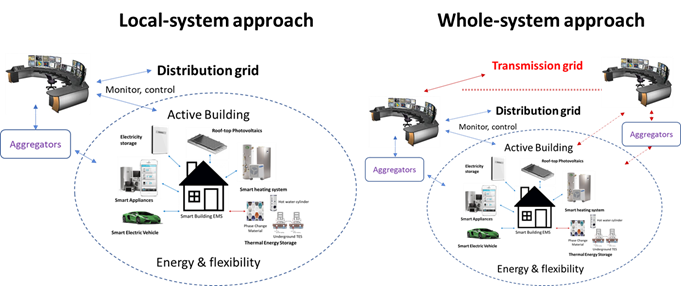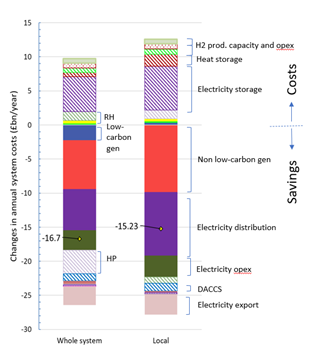The slogan “think globally, act locally” has been an integral part of developing business strategies and climate actions, but you may wonder; how relevant is it in the context of zero carbon and active buildings?
The transformation from passive to active enables heat and electricity demand or generation to be controlled and adjusted intelligently, based on triggers from the building occupant or wider grid.
Understanding the role and value of active building technologies, as discussed in our White Paper, from both local and national system perspective will be essential. The objective, at a high-level, is to minimise peak demand, improve self-consumption of energy generated locally from renewable sources, and reduce the building’s carbon footprint. There is an expectation that by increasing these capabilities at a buildings level, there will be a reduction of energy local distribution costs. This, in turn, will also reduce the overall generation and transmission costs as energy synergies across these power system components increase.
While optimising the energy system at a local level is often the centre of current practice, the idea of using active building flexibility for the national energy system (beyond the local system) is appealing. However, the benefits of active buildings, and how they will change the system’s evolution need a little exploration . With this in mind, we tested two active building optimisation strategies, analysed the system implications, and quantified these two cases’ cost performance.

The local-system approach centres on the idea outlined earlier; that above where active building flexibility is used to minimise the cost of distribution network reinforcement. It involves load-shifting, balancing the local demand, output from local renewable generation, and storage using battery or thermal stores. To achieve this, active buildings monitor, optimise, and control electric vehicles, smart appliances (e.g. washing machines, dryers, dishwashers, fridges), and heating/cooling systems, and other electricity loads (e.g. lighting). Similarly, active buildings also forecast and monitor local energy resources (e.g. PV, solar thermal, CHP and others) for optimising the building energy management system. The active building control system also interacts with the local distribution system operator’s (DSO) control system to understand the local grid constraints. If there is any active local constraint, the active building flexibility will alleviate the constraint by managing the building’s energy import/export accordingly.
On the other hand, the whole-system approach will require a more complex setup as active building flexibility will also be used by the transmission system operator (TSO) to manage the system balancing and transmission at the national level. It requires deeper TSO-DSO coordination beyond the current practice (i.e. DSO has not been an active agent for interfacing distributed flexibility resources to TSO). While there is a synergy between TSO and DSOs; this does not always happen. For example, when the TSO needs the flexibility to absorb the output from surplus offshore wind (where nobody lives), active building flexibility may overload the local wires if they do not have sufficient network capacity.

The chart to the left shows the system implications and benefits of active building flexibility using the two optimisation strategies outlined. It compares the system costs with and without active building flexibility. A negative value means savings, and positive means additional costs.
We found that both approaches reduce the system costs substantially, by between 15.2 – 16.7 £bn/year. The local approach reduces the electricity distribution network costs more significantly than the whole-system approach, however it also results in lower levels of low-carbon generation investment. In total, the benefits of the whole-system approach are £1.5bn/year greater than if we were to take a local approach. The local approach will also require more investment in electricity storage, heat storage and heat pumps.
Well, does it conclude that “Think globally, act locally” also applies in this case? Yes, it does.


